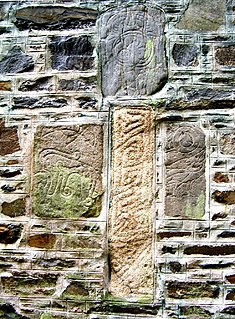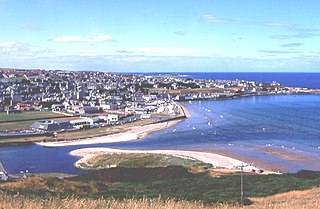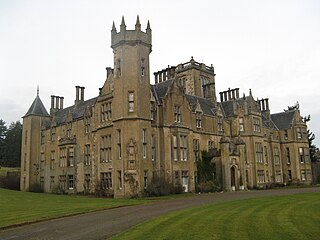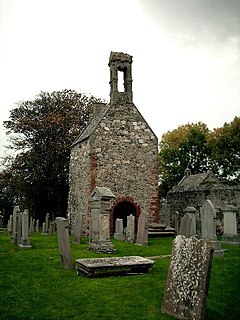
Fraserburgh is a town in Aberdeenshire, Scotland with a population recorded in the 2011 Census at 13,100. It lies at the far northeast corner of Aberdeenshire, about 40 miles (64 km) north of Aberdeen, and 17 miles (27 km) north of Peterhead. It is the biggest shellfish port in Scotland and one of the largest in Europe, landing over 5,450 tonnes in 2016. Fraserburgh is also a major port for white and pelagic fish.

Turriff is a town and civil parish in Aberdeenshire in Scotland. It lies on the River Deveron, about 166 feet (51 m) above sea level, and has a population of 5,708. In everyday speech it is often referred to by its Scots name Turra, which is derived from the Scottish Gaelic pronunciation.

Fyvie is a village in the Formartine area of Aberdeenshire, Scotland.

Peterhead is a town in Aberdeenshire, Scotland. It is Aberdeenshire's biggest settlement, with a population of 18,537 at the 2011 Census. It is the biggest fishing port in the United Kingdom for total landings by UK vessels, according to a 2019 survey.

Old Deer is a parish and village in the district of Buchan, Aberdeenshire, Scotland. The population in 2011 was 152. The village lies on the Deer or South Ugie Water, 10.1 miles (16.3 km) west of Peterhead and 2 miles (3 km) from Mintlaw. Industries include distilling, brewing, and the manufacture of woollens, and there are quarries of granite and limestone.

Banff is a town in the Banff and Buchan area of Aberdeenshire, Scotland. It is situated on Banff Bay and faces the town of Macduff across the estuary of the River Deveron. It is a former royal burgh, and is the county town of the historic county of Banffshire.

New Deer is a settlement in Aberdeenshire, North East Scotland, which lies in the valley of Deer. It is located at the junction of several roads crossing through the Howe of Buchan. It was founded after monks from Deer Abbey, Old Deer, built a chapel at Auchreddie, which translates as "field of the bog myrtle", and lies clustered on both sides of the slope of a tributary of South Ugie Water. Around 1507 the register of Deer Abbey lists its lands in the "new paroche of Deir". The name Auchreddie has dropped in significance over the years; however, the southern end of the village is still known by this name.

Longside is a village located in Aberdeenshire, Scotland, consisting of a single main street. It lies seven miles inland from Peterhead and two miles from Mintlaw on the A950. Its population in 2001 was 721. The River Ugie flows through it.

Cuminestown is a village in the Formartine area of Aberdeenshire, Scotland, and sits at the centre of the parish of Monquhitter. It is approximately 6 miles from Turriff and New Deer, 10 miles from Macduff and Banff and 15 miles from Fraserburgh.

John Smith was a Scottish architect. His career started in 1805 and he was appointed as the official city architect of Aberdeen in 1807, the first person to hold this post. Together with Archibald Simpson, he contributed significantly to the architecture of Aberdeen, and many of the granite buildings that gave the city the nickname 'The Granite City' or also 'The Silver City' are attributed to them.

Fordyce is a village in Aberdeenshire, Scotland that is slightly inland from the point where the Burn of Fordyce meets the sea between Cullen and Portsoy. It has existed since at least the 13th century. In 1990, Charles McKean wrote that Fordyce was "a sheer delight to discover, concealed as it is from the passing eye by hills and rolling countryside".

Tyrie is a hamlet and parish in the Banff and Buchan district of Aberdeenshire, north-east Scotland. Tyrie is located on the A98 road, around 5.5 miles (8.9 km) south-west of Fraserburgh. Tyrie parish includes the larger settlement of New Pitsligo, 5 miles (8.0 km) to the south. There is a primary school in the village. Tyrie's St Andrew's Parish Church was built in 1800 and is a category B listed building. The church contains a Pictish symbol stone, known as the Raven Stone, which was discovered on the site of the old parish church. The ecclesiastical parish was united with Strichen parish in 2002.

Dyke Parish Church is a Georgian church in Dyke, a village in Moray. In active use by the Church of Scotland since it was built in 1781, it stands on the site of a mediaeval church, and incorporates an older mausoleum, which is now the church hall and vestry. An early mediaeval Pictish cross slab, and a twelfth century coin hoard were discovered in the grounds while the church was being built. It was designated a Category A listed building in 1971.

The Old Church of St John is a ruined church, incorporating a finely carved sacrament house and situated within a historic burial ground in Kirktown of Deskford in Moray, Scotland. The church, along with the remains of the Tower of Deskford which was formerly attached to it, is a scheduled monument; the burial grounds and enclosing wall, excluding the other structures, are designated as a Category A listed building.

St Rufus Church, also known as Keith Parish Church, is a Church of Scotland church in Keith, Moray, that was built in 1816. Designed by James Gillespie Graham in the Perpendicular Gothic style, it has crenellated walls, traceried windows and a tall bell and clock tower at its west end. The doorway leading into the nave from the entrance lobby is an unusual war memorial, listing the names of parishioners who died in the First World War on one side, and in the Second World War on the other.

Old St Peter's Church is a scheduled monument in Peterhead, Aberdeenshire, Scotland. While the medieval main tower is still standing, only ruins remain of its other sections, some of which date to the 12th century. The pyramid roof of the tower is believed to be 18th century.

Old Parish Church is a Category A listed building located on Maiden Street in Peterhead, Aberdeenshire, Scotland. Local brothers Robert and John Mitchell built the church between 1804 and 1806, to a design by Alexander Laing, of Edinburgh. Its Burgerhuys bell dates to 1647.

Rathen, Aberdeenshire, is a parish and hamlet near Fraserburgh, Scotland. In Scottish Gaelic, its name means fort on the river.

Cruden Bay Hotel was a hotel in Cruden Bay, Aberdeenshire, Scotland. Following the success of the Palace Hotel in Aberdeen, it was built between 1897 and 1899 by the same owners. It closed in 1932 and was demolished between 1947 and 1952.

St Talogan Parish Church is a ruined church in Fordyce, Aberdeenshire, Scotland, of which only the chancel and western tower remain. Now a scheduled monument, having formerly been Category A listed, a structure on the site has existed since at least the 13th century.























